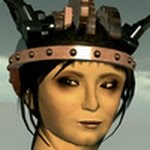
Photographs courtesy of [DAM]Berlin - All rights reserved
Posted by Bettina Tizzy
In Hammering the Void, there isn't just one Gazira Babeli, there are 14 and they all fight against an inner void. 14 clones of an artificial person, they are each named after Virtues and Sins: Greed Petrovic, Sloth Swansong, Temperance Navarita, Courage Sparta, Envy Sixpence, and more. Equipped with a hammer in their hands, they descend from the pedestal in the gallery, they swarm to openings of exhibitions and public events. They strike other unsuspecting avatars with blows from their hammer as if to say: "Wake up! Defend yourself! Act!" They force others to react. You love them or you hate them, but you cannot remain indifferent against this aggression, which can be understood as an attempt to awaken the intellect or simply as a malice.
Friday, May 29th marks the opening of Gazira Babeli's newest mixed realities show, which will run through July 31st at the [DAM]Berlin gallery in Berlin and concurrently in Second Life®. A new film will be screened.
May 29, 2009:
10pm - 12am at Locusolus - [DAM]SecondLife, teleport directly from here
7-9 PM in the gallery [DAM]Berlin
Man Machinaga (aka Patrick Lichty) is a technologically-based conceptual artist, writer, independent curator, animator for the activist group, The Yes Men, a founding member - along with Gazira - of the virtual performance art group Second Front, and executive editor of Intelligent Agent Magazine. He is a member of the faculty of the Interactive Art & Media Department of Columbia College, Chicago. He writes...
By Patrick Lichty
As I write this, Gazira and I are talking about my reflections on Hammering the Void, and in dealing with the moral tropes of Sin, Virtue, and most romantically, Truth, it seems that my text less resembles an essay and is more like a sermon. As this is no more surreal than reflecting on the moral implications of a horde of fourteen proxies wielding cartoon mallets, I'd like to frame this under just such a conceit of a sermon on virtual existence. Let us consider then, my Brothers and Sisters in Virtuality and Hypereality, the implications of unleashing Pandora's Box, of unfurling the Sins and Virtues forth into the Nets, armed with nothing less than Vulcan's Hammer itself; let us consider the effects thereof. I want to say that in setting this forth, the traditional Sins and Virtues give rise to four Principles of experience that remain in virtuality, and those are: Affect, Agency, Volition, and Complicity. It is through these that while after shedding the physical coil, humanity follows us into the Void. Let us meditate upon these in that we may understand the Void.
In the beginning of the Hammering the Void introductory video, Gazira and I (or my Man Michinaga proxy) sit before a screen in Second Life, marveling at an opening of 90's net artists, Vuk Cosic and Alexei Shulgin. We gesticulate excitedly like old heavy metal fans about the “Monsters of net.art." We agree that she must set the cloud of Gaziric Sins and Virtues upon the world, equipped with large mallets, perhaps as inquisition, perhaps as divine intervention. For the rest of the video, the Gazirae invade virtual social events akin to a host of viral Agents (as per the “Smiths” from Matrix Reloaded) creating avatar mosh pits and hammering the hapless onlookers. All of this would appear as simple farce; but I know Gazira, and we know one thing...
The Truth is out there, we are all complicit in its creation, and Gazira is hammering you over the head with it.
One point that is essential to consider when looking at the gaggle of Gazirae and their accouterments, is that she has provided the hammer in the gallery for you. 
Nice to Meet You Mallets
They aren't inflatable hammers, either. They're probably oak or maple, engraved with the Deadly Sins and Noble Virtues, inviting you to pick them up and play. As a side note, I had considered being more explicit in regards to “play," but doing so would have been too heavy-handed, which is unnecessary when one is wielding an oak mallet.
As Gazira and I have continued to make works in virtual worlds for years, the question returns to the “why," which may return us to the Cartesian cogito. However, I would like to remap the Cartesian assertion into a consideration of the increasing retreat into virtual worlds in asking about some of the things that remain in our Pandora's Box of simulation when we remove materiality and embodiment. This leads us back to the fulcrum of our sermon; the median icon of our discussion.
The sign at the center of this discussion is the hammer, the archetypal sign of Vulcan/Hephaestus, the God of Technology and Artisans. In Hammering the Void, perhaps the null-stuff of virtuality is the metal of disembodied existence that the Gazira-Hephaestae forge into an ironic tool for dragging our own mortal encumbrance into cyberspace. Her traditional Sins and Virtues infest the online worlds, placing all they encounter upon the existential anvil or litmus test of action and reaction. There is little time for reflection, for what is under the hammer nothing less than our human nature. What do you do? From this vantage point, the result is the transmutation of the traditional Sin/Virtue binaries into monads of four human elements of virtual existence. These Monads, as we have transmuted beyond Sin or Virtue, are the principles of Affect, Agency, Volition, and Complicity. which are all complex significations embedded into Gazira's Hammer.
Affect: Identification with the act. One of the most striking images of the Gazirae is that of the fourteen Sins/Virtues rampaging before their puppeteer in a bold thrust, akin to an ideologue ordering their army into action. This encapsulates this writer''s fascination with the evident identification of increasing numbers with virtual worlds, and as of this writing, there were 65,000 people logged into the single online world of Second Life alone, showing the “reality” of virtual reality. This evidence is also embedded within the results of each intervention of the Gazirae, from the amusement of the appearance in the Uqbar region, varying to confusion and even anger in other instances. The paradoxical question of the visceral reaction to virtual events shows that affect is not just for identification for another body, but for an identification with their proxies/avatars as well. Although the avatar version of Burden's Shoot (Kildall or Mattes) is different from the first, both create a “gut reaction”. There is reality in the virtual.
Agency: The act of intervention. If the avatar did not have some sense of real agency, some ability to intervene in affairs, this essay would not exist, as Gazira would have had no effect. Perhaps this is a realization of Baudrillard's primacy of the hyperreal – the object/image that has greater effect than its subject. But this is in agreement with the principle of Agency, as Gazira, and her doppelganger Gazirae, the replicants controlled by a simulacrum, create reaction to her actions. Although this may sound like the erection of a wilderness of mirrors, there are vectors of effect as well as affect when the hammer swings. The effects of the impact (to paraphrase Sanborn) of the virtual mallet are evident in that they set off chains of causality in the physical, even if they are as simple as the fact that she occupies a space in which the hammer is realized in a gallery, asking you to pick it up and swing it yourself. And more specifically, the way she does.
Volition: The will to action. The fact that Gazira sets her plan in motion is a testament to the principle that one has the ability to act through the virtual. The Aktion zur Macht breaks the stasis of virtuality, setting forth the path of agency to the creation of affect. Through the creation of the Sins and Virtues, Gazira has set them upon others, setting up causal chains, however slight, but this prime mover, probably the simplest, is a fundamental factor of intervening.
Complicity: The inseparability from the act, or the impossibility of total abstraction. The double sign of the hammer in the virtual and the physical and their similar functions illustrates our complicity with actions in either world. Through the hammer, argument of separation of subject and object through mere virtuality implodes, as the difference is far more complex. It is no longer the question of the effects of hitting someone with the hammer in the gallery or in the virtual, as both actions hold us complicit with the real issue of violence itself actual or implied, leaving the hammer itself transparent. Violence through cartoon or oak mallet differ little in terms of their being consistent with the same practice, and that is the gesture of the swing, and the effect of the impact. Gazira and her vices/virtues ask you to pick up the hammer and hit your friend over the head with it, but then say, “Funny, that doesn't happen here... Ahahahah....” through this doubling and the resultant difference of effects, Gazira holds us responsible for the violence of signs, the affect of the impact, the effect of the hammer's extancy, the volition of the swing, and the complicity to the hammer and its function.
Before ending my sermon, I would like to talk about the narcissism of the Global Village; of cyberspace. As McLuhan said,
"The global village is a world in which you don't necessarily have harmony. You have extreme concern with everybody else's business and much involvement in everybody else's life. It's a sort of Ann Landers column writ large... huge involvement in everybody else's affairs. So the Global Village is as big as a planet and as small as the village post office."
In many ways, this intense concern is emblematic of the collective dream of pop technoculture less from from Star Trek and more to World of Warcraft. The shift of focus away from the outward vision of Buckminster Fuller 's “Spaceship Earth” to the inwardly looking complicit panopticism of McLuhan's “Global Village” seems to be the object of the swing. Perhaps this inward look is the gaze into the abyss that Gazira is hammering at. Rather than “leaping into the void” a la Klein, is Gazira hammering away at the null-sets of illusion in the void of cyberspace to get at the truths that remain in virtual existence? Is there anything there?
Or is she merely asking you to hit your friend in the face with an oak mallet because that is the most fundamental form of human communication remaining?
In the end, what remains is a communion of reflection; something that is considered an endangered species in the age of constant partial attention deficit. As the Gazirae descend upon us, there is a moment in which we are forced to meditate upon the four elements of human existence in the virtual, and then the offering is put forth.
The Hammer of Gazira. Given for you. May it dispel your illusions.
Now, SWING.
Amen.
Patrick Lichty
Thursday, May 28, 2009
She[s] got a hammer: Hammering the Void
Posted by
Bettina Tizzy
at
11:42 PM
![]()
Labels: [DAM]Berlin, art, conceptual art, Gazira Babeli, Man Machinaga, mixed realities, new media, Patrick Lichty, performance art, Second Life®, sin, virtue








2 comments:
Thank you for the superb timing of this post Bettina! It is exactly what the doctor has ordered for today:
http://alphaauer.wordpress.com/2009/05/29/a-few-thoughts/
;-)
Fantastic Post
Post a Comment